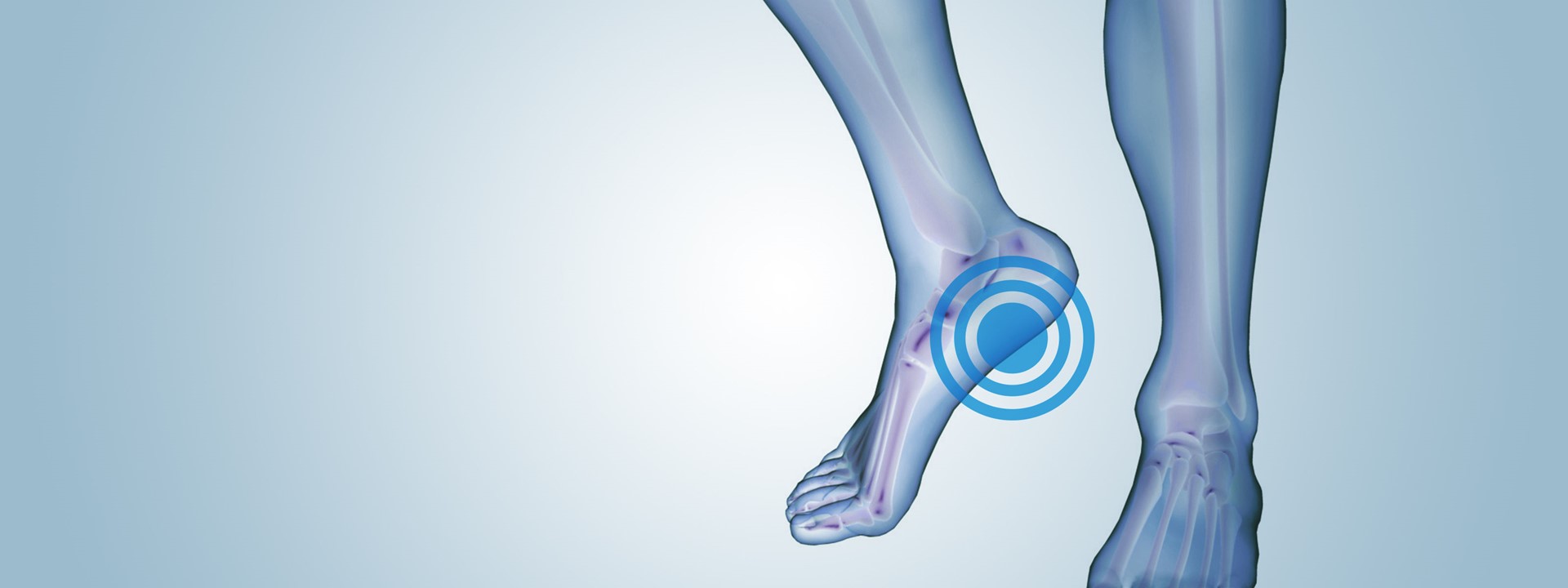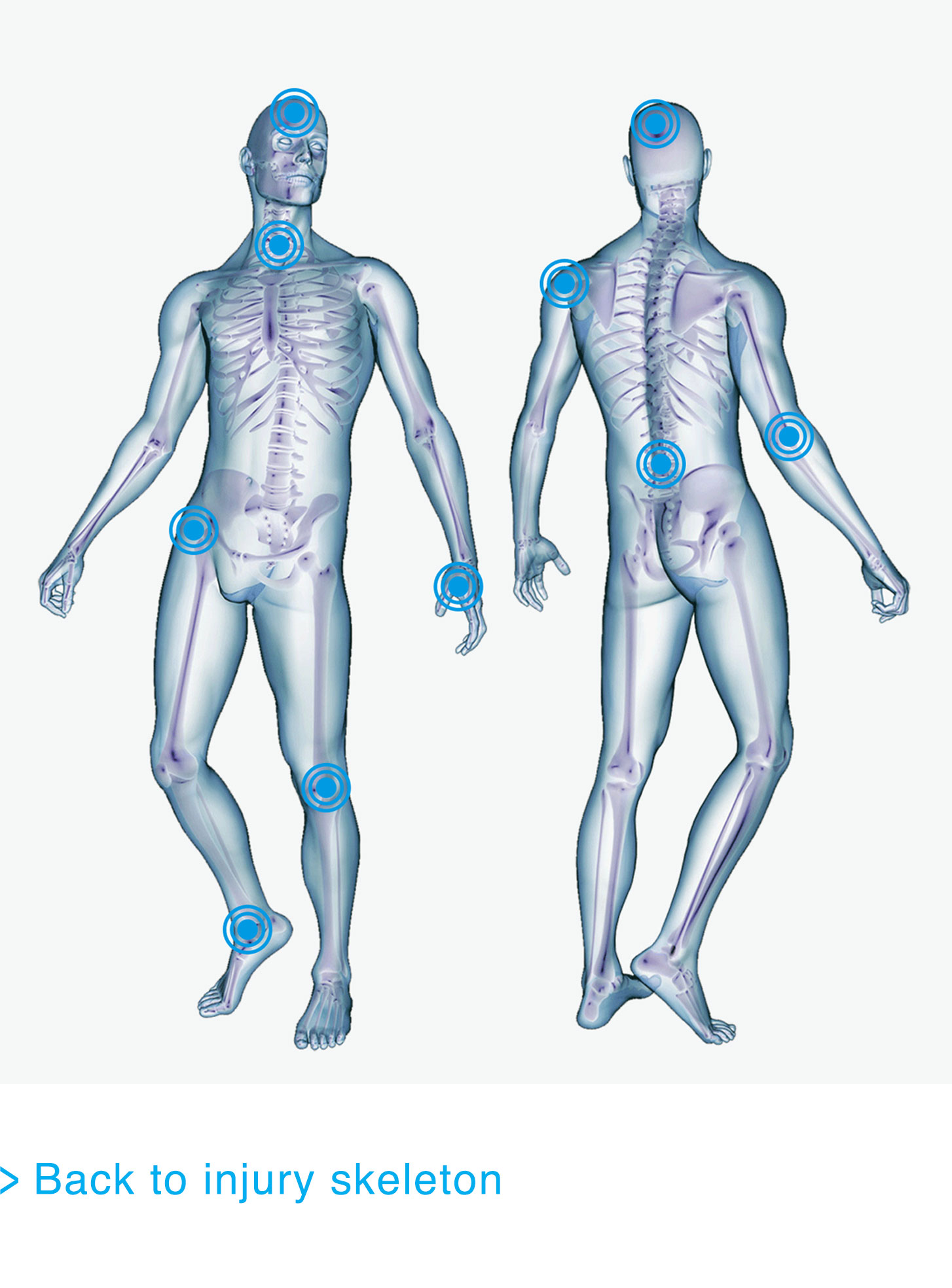Foot and ankle injuries are relatively common. For example, it is estimated that around 5,000 people sprain their ankle each day in the UK. However, such injuries are often fairly minor and will improve within eight weeks.
Fascinating facts
- A quarter of all the bones in the body are in our feet. There are 26 of them, and each foot also has 33 joints and 19 muscles.
- 'Elvis foot' is climbers’ jargon for being so tired that your foot trembles on the rock.
- Brahim Takioullah from Morocco has the world's largest feet. His left foot is 1ft 3in, while his right measures 1ft 2.76in. His enormous height also makes him the world's second tallest man, two inches behind Sultan Kosen of Turkey, who stands at 8ft 3in.
- The pressure on the feet when running can be four times the runner's weight.

Related injuries
Break it like Beckham... and Rooney and Gerrard. Metatarsals are the long and slender bones in your foot that join your toes to your mid-foot. There are five metatarsal bones in each foot and they help with balance, propulsion and gait maintenance.
Occurrence/Frequency of Injury
Fractures are caused by trauma/impact injury, overuse (stress fracture) or by rolling over on your ankle. The fifth metatarsal is the most commonly injured and is located on the outside of your foot.
Treatment and Recovery Timeframes
These fractures do not normally require surgery and would be expected to heal on their own in about five to six weeks.
Normally, once diagnosed, people are given a removable plastic cast and advised to walk as this helps with healing. Stress fractures normally occur in young people and are a result of overtraining. Given they are not caused by any impact/trauma, they can be difficult to diagnose.
Those in sedentary roles should be able to return to work after a week or pain allowing. Those with manual jobs who are required to stand may require up to a month or until they can tolerate prolonged standing again.
Interesting Facts
If you're not a professional sportsperson, there's not a lot you can do to expedite the healing of this fracture, unless you have an oxygen tent in your garden!
The Achilles tendon, (known as the calcaneal tendon or the tendo calcaneus), is a tendon of the back of the leg that attaches the calf muscles to the heel bone.
Tendonitis is a term which means inflammation or swelling, and is a common injury to the Achilles. There are two areas of the Achilles prone to this problem:
1) in the middle of the tendon (mid-substance Achilles tendonitis)
2) at its insertion into the heel bone (insertional Achilles tendonitis).
In both forms of tendonitis the pain is often worst first thing in the morning and after periods of rest, so-called 'start up' pain. Once the individual has 'warmed up' the symptoms often improve.
Occurrence/Frequency of Injury
Achilles tendonitis presents as a painful swelling of the tendon and is often seen in long-distance runners. However, it can follow unaccustomed activity or after a minor injury. Sometimes it occurs in the elderly after taking certain antibiotics.
Treatment and Recovery Timeframes
In many people, the condition will improve with time, but can take a frustratingly long period (up to 12-18 months). Taking anti-inflammatory medication, activity and footwear modification will improve the condition, but the mainstay of treatment is physiotherapy.
Physiotherapy will focus on stretching and strength restoration in the initial stages, but should also focus on the underlying cause. In most cases Achilles injures are caused by an underlying muscle or structural issue that needs to be resolved.
For those individuals whose symptoms fail to settle, surgery has a lot to offer. In some cases, a para-tendon strip and tendon debridement (tidy-up) can help a lot and in severe cases a tendon transfer can be successful.
For insertional tendonitis, removal of the prominent bone and debridement of the tendon can be successful.
Interesting Facts
The name 'Achilles' heel' comes from Greek mythology. Achilles' mother dipped him into the River Styx to supposedly protect his body from harm. However, she kept hold of his heels, meaning that the water did not touch this part of his body and it was therefore vulnerable. During the Trojan War, Achilles was struck on his unprotected heel by a poisoned arrow shot by Paris.
A sprain is an injury to a ligament. Ligaments are strong tissues around joints that attach bones together and give support to joints. A ligament is usually injured when it is over stretched during a sudden pull. The ligaments on the outside of the ankle (anterior talofibular, calcaneofibular and posterior talofibular ligaments) are the most commonly sprained ligaments in the human body.
Occurrence/Frequency of Injury
A damaged ligament causes inflammation, swelling, and bleeding (bruising) around the affected joint. Movement of the ankle joint is painful when you have a sprained ankle. The severity of a sprain is graded into three categories:
Grade I - mild stretching of the ligament without joint instability.
Grade II - partial rupture (tear) of the ligament but without causing joint instability (or with mild instability of the joint).
Grade III - complete rupture (tear) of the ligament with instability of the joint.
Ankle Sprains are some of the most frequent injuries that present at A+E departments and occur in sports such as skiing and football. In the workplace, common causes include walking on uneven factory floors, stepping from heights or from slipping.
Treatment and Recovery Timeframes
In the first 48-72 hours after a sprained ankle, PRICE (Protection, Rest, Ice, Compression, and Elevation) principles need to be followed and sufferers should try to avoid HARM activities (Heat, Alcohol, Running, and Massage). Painkillers or anti-inflammatory tablets can be taken and can help settle the symptoms.
Most sprains heal within a few weeks, but severe sprains where the ligament ruptures (tears badly), a brace or plaster cast may be provided. In some cases surgery is advised if the sprain is severe and there is some bone involvement (fractures at the site of ligament attachment) but often this is not diagnosed until some time after the accident.
Grade II/III strains benefit from physiotherapy, which works to restore the strength and stability following an injury, in turn reducing the chance of an injury reoccurring.
Interesting Facts
An estimated 5,000 people sprain an ankle each day in the UK. You can avoid being one of them by ditching the stilettos! Wear boots that give ankle support rather than shoes in the workplace, particularly when walking on uneven ground and for manual labour.
Plantar Fasciitis is inflammation of the connective tissue on the sole of your foot. Plantar Fasciitis sufferers will complain of pain and stiffness in the bottom of the heel or a burning sensation in the arch of the foot. The condition is thought to arise from overuse of the plantar fascia. Pain may be worse in the morning when first getting up, after standing or sitting for a while, while climbing stairs or after intense activity.
Occurrence/Frequency of Injury
Plantar Fasciitis most often affects active men between the ages of 40 and 70. It is one of the most common orthopaedic complaints relating to the foot. Repeated small injuries having an accumulative affect on the fascia (with or without inflammation) are thought to be the cause of Plantar Fasciitis, but it still isn't 100% proven to be the cause. Risk factors include spending excessive time on your feet, obesity, fallen foot arches, wearing unsupportive shoes, tight calves and gait problems.
Treatment and Recovery Timeframes
Plantar Fasciitis can be notoriously slow to resolve. The goal of treatment is to reduce inflammation, allowing small tears to heal, stretch and strengthen the foot. Most people will recover without surgical intervention within a year, but it can be a frustrating time while they wait for the condition to settle.
The evidence on how best to treat Plantar Fasciitis is poor, but initially resting, wearing supportive shoes, taking anti-inflammatory tablets and simple stretches are suggested. In most cases this will resolve the problem, but if no improvement is seen within six weeks orthotics may be necessary along with a night splint, which helps stretch the fascia and restore normal range of movement.
If no improvement is seen, surgery can be provided, but there is no conclusive evidence of its long term effectiveness compared with a conservative approach. Surgery involves cutting part of the fascia to release the tension and relieve inflammation.
Those working in a sedentary role that doesn't involve standing would not be expected to require any time off work as pain symptoms can be managed with rest. Those in manual work or roles that require long periods of standing can find it difficult to return to work and will often aggravate the condition by returning too soon when symptoms have decreased. Employees may need to be able to take regular rest breaks and, if the role can be completed while seated, this modification should be made.
Interesting Facts
Plantar Fasciitis is otherwise known as Policeman's Foot as many Policemen (and women) suffered from the condition due to the time they use to spend walking the beat. Unsurprisingly, it isn't believed to be as common among policemen and women today.
Shin Splints is characterised by pain in the lower part of the leg between the knee and the ankle. Shin Splints commonly affects athletes who engage in running or physical activity. Some of the muscles in the foot attach to or around the shin and the repetitive action of these muscles pulling at the point where they attach to the bone causes irritation to the tendon and the bone.
Occurrence/Frequency of Injury
The injury can usually be attributed to overloading the muscles of the lower extremities or biomechanical irregularities. For example, the motion of running can put excessive stress on the muscles, causing Shin Splints. Increasing activity, intensity, and duration too quickly is the most common cause of Shin Splints because the tendons and muscles are unable to absorb the impact of the shock force as they become fatigued. If left untreated, the injury can worsen and cause a stress fracture. Individuals with the following risk factors are the most at risk of developing Shin Splints.
- Flat feet
- Excessively tight calf muscles
- Undertaking high-impact exercises on hard, noncompliant surfaces (i.e. running on asphalt or concrete)
- Smoker and low fitness.
Treatment and Recovery Timeframes
Treatment normally consists of rest in the initial period with the use of ice and anti-inflammatories.
An assessment by a podiatrist and or physiotherapist is also recommended to determine whether the cause of the problem is biomechanical or associated with weak/tight muscles.
Biomechanical issues with the foot can be helped with orthotics. Muscle strength and length issues can be addressed by specific exercises and stretches.
In addition, modification of a training regime will be required. Normally this consists of slowly increasing activity so the body has time to adapt. Running on softer surfaces such as grass as opposed to tarmac can also help as it reduces the impact forces associated with running and places less stress on the soft tissues.
Interesting Facts
The worst bit of advice you can give someone with Shin Splints is to tell them to run through the pain. It will just make the injury worse!


